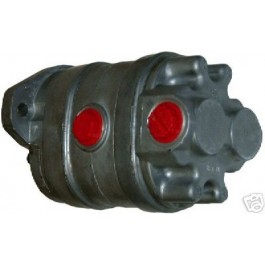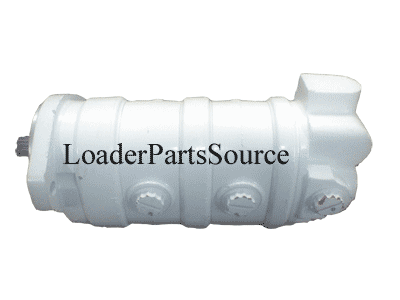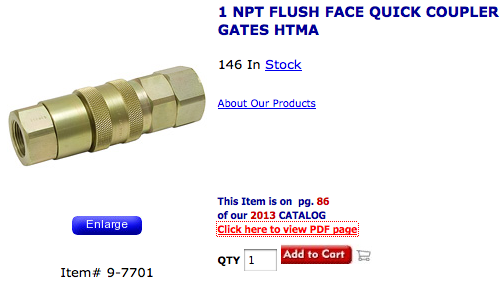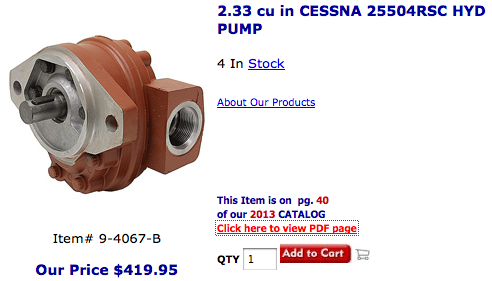Hydraulic Hose Sizing
Horsepower to Flow
First of all, we must determine fluid flow rate from the horsepower and pressure.
Horsepower = Pressure × Flow / 1714, or:
- Flow Rate (GPM): Q = (HP * 1714) / (P * 2)
- Note: SurplusCenter says for gas driven pumps, double the horsepower (or halve the flow rate for fixed hp).
- Pump Displacement (CIPR): D = Q * 231 / (RPM * 0.97)
- (CIPR = Cubic Inches Per Revolution)
| HP | RPM | PSI | Flow Formula | GPM | Displacement Formula | Displacement |
|---|---|---|---|---|---|---|
| 7 | 3600 | 3000 | (7 * 1714) / (3000 * 2) | 2 GPM | 2 * 231 / (3600 * 0.97) | 0.132 |
| 28 | 3600 | 3000 | (28 * 1714) / (3000 * 2) | 8 GPM | 8 * 231 / (3600 * 0.97) | 0.53 |
| 50 | 2700 | 3000 | (50 * 1714) / (3000 * 2) | 14.3 GPM | 14.3 * 231 / (2700 * 0.97) | 0.95 |
| 50 | 2700 | 2500 | (50 * 1714) / (2500 * 2) | 17.14 GPM | 17.14 * 231 / (2700 * 0.97) | 1.13 |
| 65 | 2700 | 3000 | (65 * 1714) / (2500 * 2) | 18.57 GPM | 18.57 * 231 / (2700 * 0.97) | 1.637 |
I haven't been satisfied with these numbers, as the displacement seems too small and would likely result in not enough flow. It is only an 18.6% increase in displacement even though the horsepower has doubled and the RPM is 25% lower.
In the past, the preferred power for the LifeTrac has employed ~54 horsepower @ 3600 RPM to drive two pumps, each about 0.92 cu in displacement. This has proven satisfactory and is the rule against which the new Power Cube will be measured. The total pump displacement was 1.84 CIPR (Cubic Inches Per Revolution). This gives a ratio of HP:Flow of 54:(1.84 * 3600).
For the new Power Cube, the engine will be producing between 50 and 60 hp @ 2700 RPM (the RPM yielding max torque). So, using the above ratio to derive the new displacement as follows for 50, 60 HP @ 2700 RPM and 51 HP @ 1800 RPM:
54:(1.84 * 3600) = 50:(R * 2700) -or- R = 50 * 1.84 * 3600 / (54 * 2700) = 2.271 CIPR
54:(1.84 * 3600) = 60:(R * 2700) -or- R = 60 * 1.84 * 3600 / (54 * 2700) = 2.726 CIPR
So, this "rule of thumb" measurement puts the displacement at about 2.5 CIPR and 28.3 GPM flow:
2.5 * 0.97 * 2700 / 231 = 28.34
Here is the case for a 51 hp engine at 1800 RPM:
54:(1.84 * 3600) = 51:(R * 1800) -or- R = 60 * 1.84 * 3600 / (54 * 1800) = 4.008 CIPR
So, this "rule of thumb" measurement puts the displacement at about 2.5 CIPR and 30.23 GPM flow:
4 * 0.97 * 1800 / 231 = 30.23 GPM
Finally, the case for a 65 hp engine at 1800 RPM (pulley reduced RPM from 2700 @ engine to 1800 @ pump):
54:(1.84 * 3600) = 65:(R * 1800) -or- R = 65 * 1.84 * 3600 / (54 * 1800) = 4.43 CIPR
So, this "rule of thumb" measurement puts the displacement at about 4.4 CIPR and 30.23 GPM flow:
4.4 * 0.97 * 1800 / 231 = 33.2 GPM
Here is the case for a 7 HP engine running at 3600 RPM:
7:(1.84 * 3600) = 51:(R * 3600) -or- R = 7 * 1.84 / 54 = 0.238 CIPR
Pump Sizing
With all this in mind, in my first thought this is the closest pump I found:
After some discussion with people who have operated the LifeTrac (the target machine for this power cube), there seems to be need for separating flow between right track, left track and the accessories (loader arms, etc). To this end, I found that typical skid steer equipment use triple or quadruple pumps and separate circuits for driven equipment. A little more digging turned up these double and triple pumps used on Bobcat equipment:

|

|
|---|---|
| Bobcat Double Pump | Bobcat Triple Pump |
Source: [LoaderPartsSource.com]
James Slade and I have discussed this at some length and decided that we'd like to use pumps and hydraulic motors similar to those in other skid steer equipment - such as those listed above. We do need some details about each of the three pumps in the "triple pump":
Max/Rated RPM Max/Rated PSI Rated GPM for each
As well as the pump dimensions, weight and operating characteristics of the built-in pressure relief valve.
It is not clear yet what the type of pumps used, but one article indicates that the tracks are driven by variable-displacement pumps and the arms & accessories driven by fixed-displacement pumps.
Note: Using multiple pumps to drive isolated circuits would result in multiple separate circuits - each with smaller hose sizes and associated plumbing. The suction plumbing could be aggregated to simplify the design to use a single suction strainer and hose. Similarly, the return plumbing could be aggregated to use a single oil cooler and return filter.
Hose Sizing
These are the formulas and guidelines for determining sizes for the three hose types: Pressure, Return and Suction. They are determined from the fluid velocity in each type of hose. There are two sets of recognized values used are:
SAE Values
- Pressure: 15 ft/sec
- Return: 10 ft/sec
- Suction: 4 ft/sec
NFP Association Values
- Pressure: 20 ft/sec
- Return: 15 ft/sec
- Suction: 5 ft/sec
The more conservative SAE values are gaining acceptance in hydraulic designers. The formula for calculating the hose size is as follows:
- V = Q / (3.117 * pi/4 * D ^ 2)
or
- D = (Q / (3.117 * pi/4 * V) ) ^ 1/2
Where:
- V is fluid velocity in ft/sec
- Q is fluid volume in gallons/min
- D is hose inside diameter in inches
Note: The sizing guidelines say to always round up.
Now, let's calculate the hose sizes:
Supply (Pressure) Hose
| Flow Rate | SAE Formula | SAE Diameter | NFP Formula | NFP Diameter |
|---|---|---|---|---|
| 13 GPM | (13 GPM / (3.117 * pi/4 * 15 ft/sec) ) ^ 1/2 | 0.595 in | (13 GPM / (3.117 * pi/4 * 20 ft/sec) ) ^ 1/2 | 0.515 in |
| 16 GPM | (16 GPM / (3.117 * pi/4 * 15 ft/sec) ) ^ 1/2 | 0.660 in | (16 GPM / (3.117 * pi/4 * 20 ft/sec) ) ^ 1/2 | 0.571 in |
| 20.1 GPM | (20.1 GPM / (3.117 * pi/4 * 15 ft/sec) ) ^ 1/2 | 0.739 in | (20.1 GPM / (3.117 * pi/4 * 20 ft/sec) ) ^ 1/2 | 0.641 in |
| 28.5 GPM | (28.5 GPM / (3.117 * pi/4 * 15 ft/sec) ) ^ 1/2 | 0.881 in | (28.5 GPM / (3.117 * pi/4 * 20 ft/sec) ) ^ 1/2 | 0.763 in |
| 32.28 GPM | (32.28 GPM / (3.117 * pi/4 * 15 ft/sec) ) ^ 1/2 | 0.937 in | (32.28 GPM / (3.117 * pi/4 * 20 ft/sec) ) ^ 1/2 | 0.812 in |
| 48 GPM | (48 GPM / (3.117 * pi/4 * 15 ft/sec) ) ^ 1/2 | 1.114 in | (48 GPM / (3.117 * pi/4 * 20 ft/sec) ) ^ 1/2 | 0.99 in |
Return Hose
| Flow Rate | SAE Formula | SAE Diameter | NFP Formula | NFP Diameter |
|---|---|---|---|---|
| 13 GPM | (13 GPM / (3.117 * pi/4 * 10 ft/sec) ) ^ 1/2 | 0.729 in | (13 GPM / (3.117 * pi/4 * 15 ft/sec) ) ^ 1/2 | 0.595 in |
| 16 GPM | (16 GPM / (3.117 * pi/4 * 10 ft/sec) ) ^ 1/2 | 0.808 in | (16 GPM / (3.117 * pi/4 * 15 ft/sec) ) ^ 1/2 | 0.660 in |
| 20.1 GPM | (20.1 GPM / (3.117 * pi/4 * 10 ft/sec) ) ^ 1/2 | 0.906 in | (20.1 GPM / (3.117 * pi/4 * 15 ft/sec) ) ^ 1/2 | 0.739 in |
| 28.5 GPM | (28.5 GPM / (3.117 * pi/4 * 10 ft/sec) ) ^ 1/2 | 1.08 in | (28.5 GPM / (3.117 * pi/4 * 15 ft/sec) ) ^ 1/2 | 0.881 in |
| 32.28 GPM | (32.28 GPM / (3.117 * pi/4 * 10 ft/sec) ) ^ 1/2 | 1.14 in | (32.28 GPM / (3.117 * pi/4 * 15 ft/sec) ) ^ 1/2 | 0.938 in |
| 48 GPM | (48 GPM / (3.117 * pi/4 * 10 ft/sec) ) ^ 1/2 | 1.4 in | (48 GPM / (3.117 * pi/4 * 15 ft/sec) ) ^ 1/2 | 1.114 in |
Suction Hose
| Flow Rate | SAE Formula | SAE Diameter | NFP Formula | NFP Diameter |
|---|---|---|---|---|
| 13 GPM | (13 GPM / (3.117 * pi/4 * 4 ft/sec) ) ^ 1/2 | 1.15 | (13 GPM / (3.117 * pi/4 * 5 ft/sec) ) ^ 1/2 | 1.03 in |
| 16 GPM | (16 GPM / (3.117 * pi/4 * 4 ft/sec) ) ^ 1/2 | 1.28 in | (16 GPM / (3.117 * pi/4 * 5 ft/sec) ) ^ 1/2 | 1.14 in |
| 20.1 GPM | (20.1 GPM / (3.117 * pi/4 * 4 ft/sec) ) ^ 1/2 | 1.43 in | (20.1 GPM / (3.117 * pi/4 * 5 ft/sec) ) ^ 1/2 | 1.28 in |
| 28.5 GPM | (28.5 GPM / (3.117 * pi/4 * 4 ft/sec) ) ^ 1/2 | 1.70 in | (28.5 GPM / (3.117 * pi/4 * 5 ft/sec) ) ^ 1/2 | 1.53 in |
| 32.28 GPM | (32.28 GPM / (3.117 * pi/4 * 4 ft/sec) ) ^ 1/2 | 1.81 in | (32.28 GPM / (3.117 * pi/4 * 5 ft/sec) ) ^ 1/2 | 1.62 in |
| 48 GPM | (48 GPM / (3.117 * pi/4 * 4 ft/sec) ) ^ 1/2 | 2.21 in | (48 GPM / (3.117 * pi/4 * 5 ft/sec) ) ^ 1/2 | 1.98 in |
Notes:
The 28 hp Briggs & Stratton engine HP is rated at 3600 RPM. The 50 hp Volkswagen engine is believed to deliver the peak torque at 2700 RPM (needs confirmation) This increased fluid flow requires quick couplers capable of handling more flow. This coupler is rated for 26.4 GPM:
